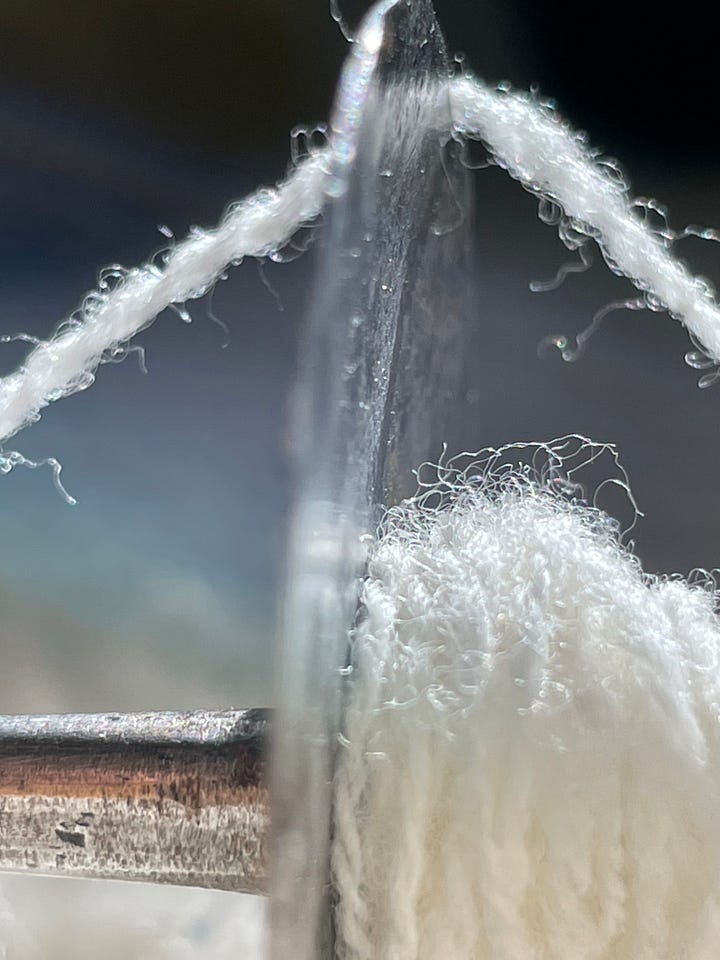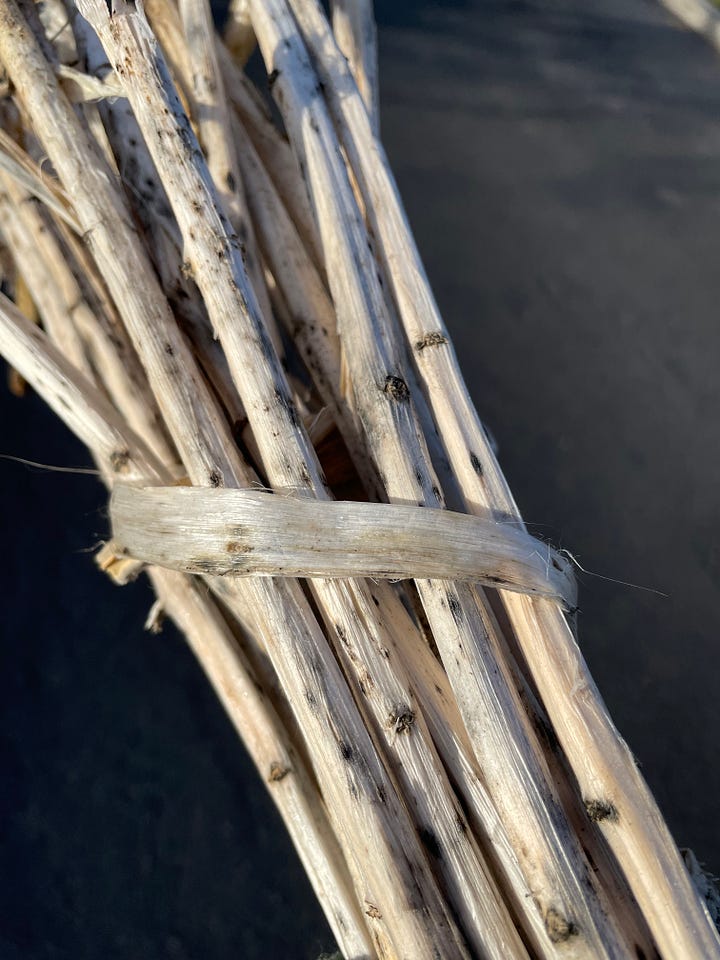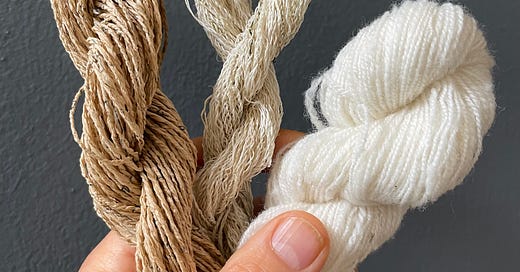When last we left this narrative thread,1 words were declining to be embroidered, tapestries were insisting on their right to be image-free, and I was in a bit of a muddle. Would these little wool tapestries really not accept a little embellishment even if I said “pretty please with spindle-spun indigo on top?”
Are they truly content and perfect as they are? And if so, what would it take for me to stand down from constantly asking, like an overeager child: "Are you ready yet? How about now?”
Of course I do not want to insist on my right to embroider2, but it has to be said that manifesting myth and metaphor with yarn is, like it or not, my job—vocation and avocation in one—and it can sometimes feel important to continue down a particular narrative path once I’ve taken a step. Just DO it, I say to myself.
Except that when I do insist, I end up stopping anyway— because those pauses are usually for a reason, I just don’t know what it is. And anyway (or so I tell myself), there is no need to get to the top of the mountain every time—and especially not if I’m already in a delightful dappled glen filled with birdsong.
The hard part is sometimes telling the difference. For all I know these minimalist tapestries already are at the top of the mountain. Then again, maybe they’re in a glen resting until the right word appears(glen perhaps?). Either way, it behooves me even more to trust that they will let me know.
And anyway, infuriating as it can be, I really do (should) know that the work shows up when my brain and body are ready.
After all, that's just what my little yellow spindle did in an uncertain moment earlier this week. Not that it shouldn't show up -- I mean it's always close at hand-- but somewhere along the line my holt3 of spindles acquired a set of invisibility cloaks that each dons or discards as circumstances dictate and sometimes I don't see them at all. Luckily this one chose visibility just at a moment when I badly needed to reduce my level of distraction.4


If you’re interested in such things, it is a Montana Targhee/Debouillet fleece I’m working on here—roving I drum carded months ago from a fleece that has already provided yarn for a blanket, a sweater, several swathes of cloth-in-waiting, a pile of skeins-in-waiting, and a third of a sweater-in-progress. It’s nice stuff. Nothing fancy or fast, but all satisfying.
Some paper surprised me right after that--not coffee filters this time5 but rather an old sewing pattern whose torn envelope burst out when I was looking for something else. I’d worked with pattern tissue before and admired its many fine qualities-- though I generally pass thinking I might still use the pattern as, well, a pattern. But this time?
“Hey you! Wanna have a good time? You’re never going to use me for sewing!”
What could I do but comply?
Unlike curved coffee filters that I cut with scissors, this paper works best with an X-ACTO which is not my favorite tool in the universe. But with a fresh blade the cuts are smooth and straight, and I prefer it to the rotary cutter I also tried. Once sliced into strips, the tissue is pretty easy to work with—smooth and strong (a relative thing to be sure when spinning found paper), and it accepts twist pretty nicely, even dry. The finished yarn is also satisfyingly flexible and very nice to knit with.
Or it would be if I had been encouraged at all. But the plied yarn declined to be manipulated any further at this time despite some not-so-subtle urging on my part, so once again I had remind myself of my belief in a yarn’s right to its own ideas—


—a thing that, for all my words about patience, my brain STILL does not like to accept.
And my wild twin is right, you never DO know what is going to happen until it appears before your astonished eyes in the first light of Saturday morning after a long run when you’re tired and a little distracted by the recalcitrance of certain projects that will not be named.
For as we rounded the last corner, what to my wondering eyes should appear but the silver grey stalks I’d hoped for all year: perfect winter-retted milkweed. Narrowly missing some early tulips leaves, I pounced.
“Can I HAVE these?” I cried.
Bemused and delighted to have one less tidy-up chore, my running partner told me to go ahead and take all I wanted.
“ALL then!,” I cried. “And just LOOK how beautiful it is. THANK YOU.”
And gleefully trotting home with the bundle of precious stalks, I knew my Saturday was now spoken for.




And oh, the pleasure of it. Damp with recent rain and morning dew, the strips of bark slipped right off—


—and white fibers lifted easily off of the now translucent bark.
My coffee grew cold and I forgot about breakfast as I twisted them into cordage. There, indeed, went the morning.




Not that I could process it all then—but over the past couple of days as the strips dried out, I’ve been able to recreate those first perfect conditions by wrapping a few at a time in a damp towel, separating out the fibers, and twisting at my leisure.
Naturally--and once again-- part of my brain dreams of what this milkweed might become (tapestry? knitted bowl? bath towel?), but equally I've not yet failed to be entrance by the rhythmic (and surprisingly efficient) cordage-making motion for which my hands were apparently designed ,6 so for now I am content. And that, as you well know, is a fine fine thing.
Well—content until the next creative conundrum comes along, whatever it might be.
Does anyone else feel a little ridiculous using textile metaphors? I mean there they are, so useful and true — yet how on earth can a person say something about life being a tapestry when for the past three decades hers has been woven, in some form or other, into cloth?
…this being an equal opportunity studio where everybody has a say.
holt: n. a wood or grove or copse
If you’re subscribed here you might have received an email or two from Substack about their new “Notes” feature — apparently their (hopefully kinder) answer to Twitter, designed for the myriad writers who have hoped for an alternative. The Substack team has been very excited about this — so excited that their emails started to sound almost mean (there’s more you could/should be doing for your readers and you’re not doing it and here’s how you can right this very second), generating more than a little angst and beautifully expressed irritation.
If you’re a regular Gusset reader and find yourself all the way down here you already know I’m more of a long form kind of gal anyway. Too many bits of input all at once (even if each is beautiful and compelling in itself), make me either shut down or rev up until I don’t know what to do or think. To be sure that is just my brain, and if you’re positively stimulated by tidbits, please do go check out Notes as there cannot help but be myriad delicious brain snacks to be found. And at the same time I hope you don’t feel too neglected if I stick with milkweed, mile-long missives, and endless spindle projects…
Still building up my stash of used ones to prepare for the tapestry, a day/pot at a time.
Here’s a bit more about making cordage—I’m using Iris and Daylily leaves, but the principle is the same. And here’s a post from a couple of years ago about things a person might do with cordage. And here is some more about my relationship with materials - especially Milkweed!

















There's a place for long-form content, a place for short-form content. We already follow you, so you can be assured we enjoy your long, meandering blogs. If you think you can provide quality short-form content for Notes, then try it, but please don't think we're suddenly gonna leave you if you stick with normal blogging .
Sarah, you’ve made my day! Thank you!